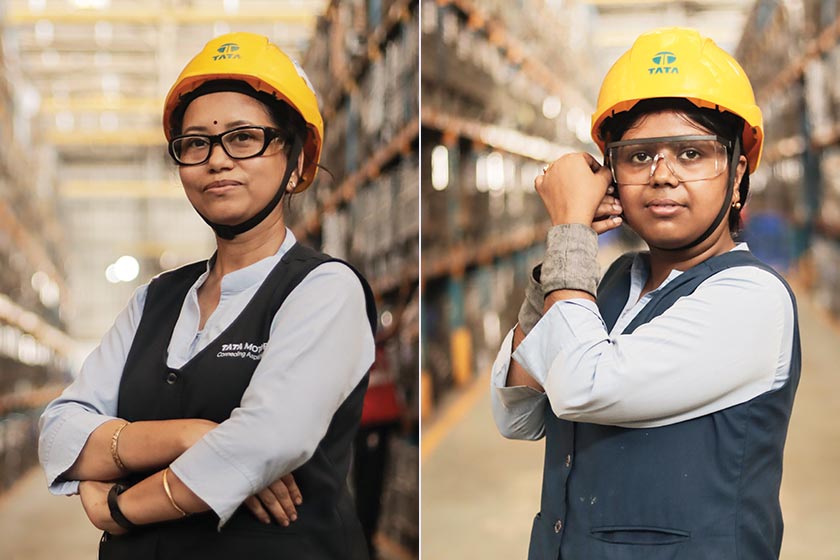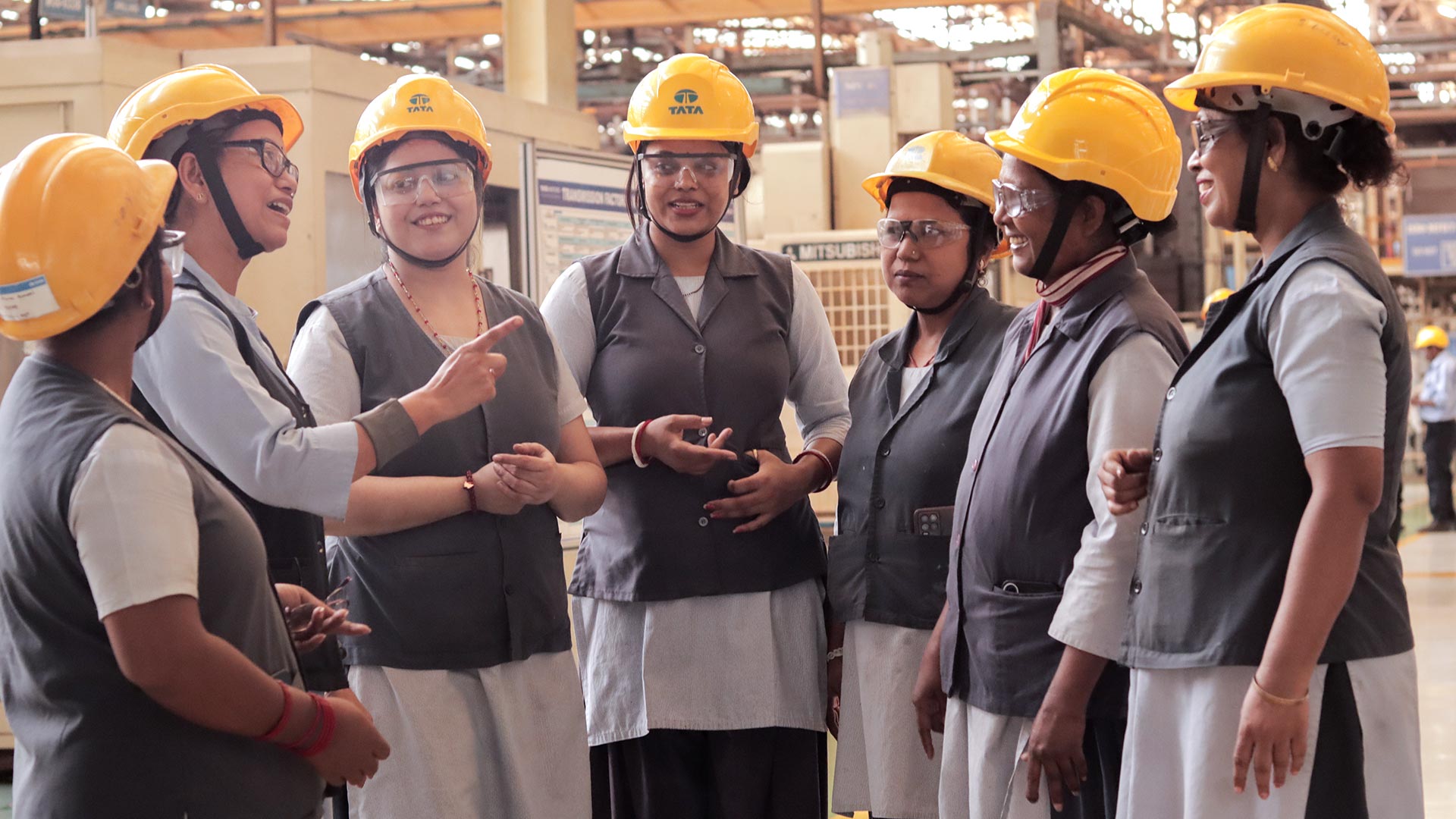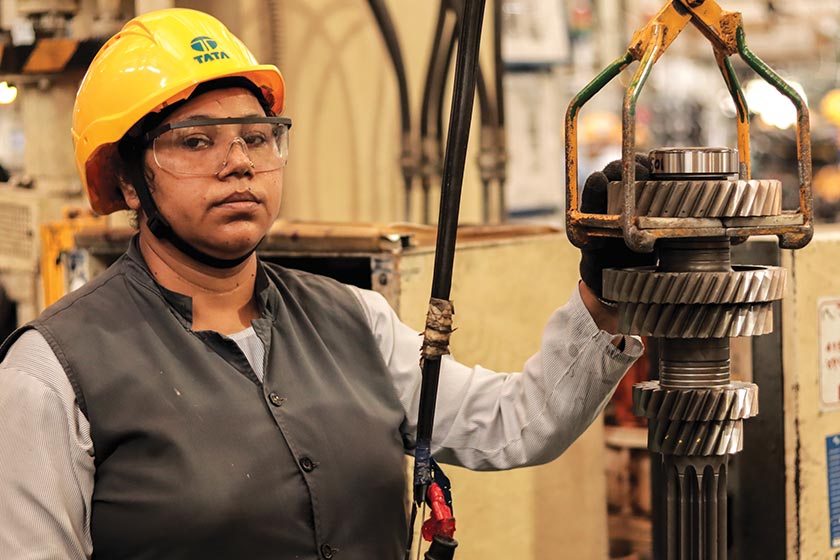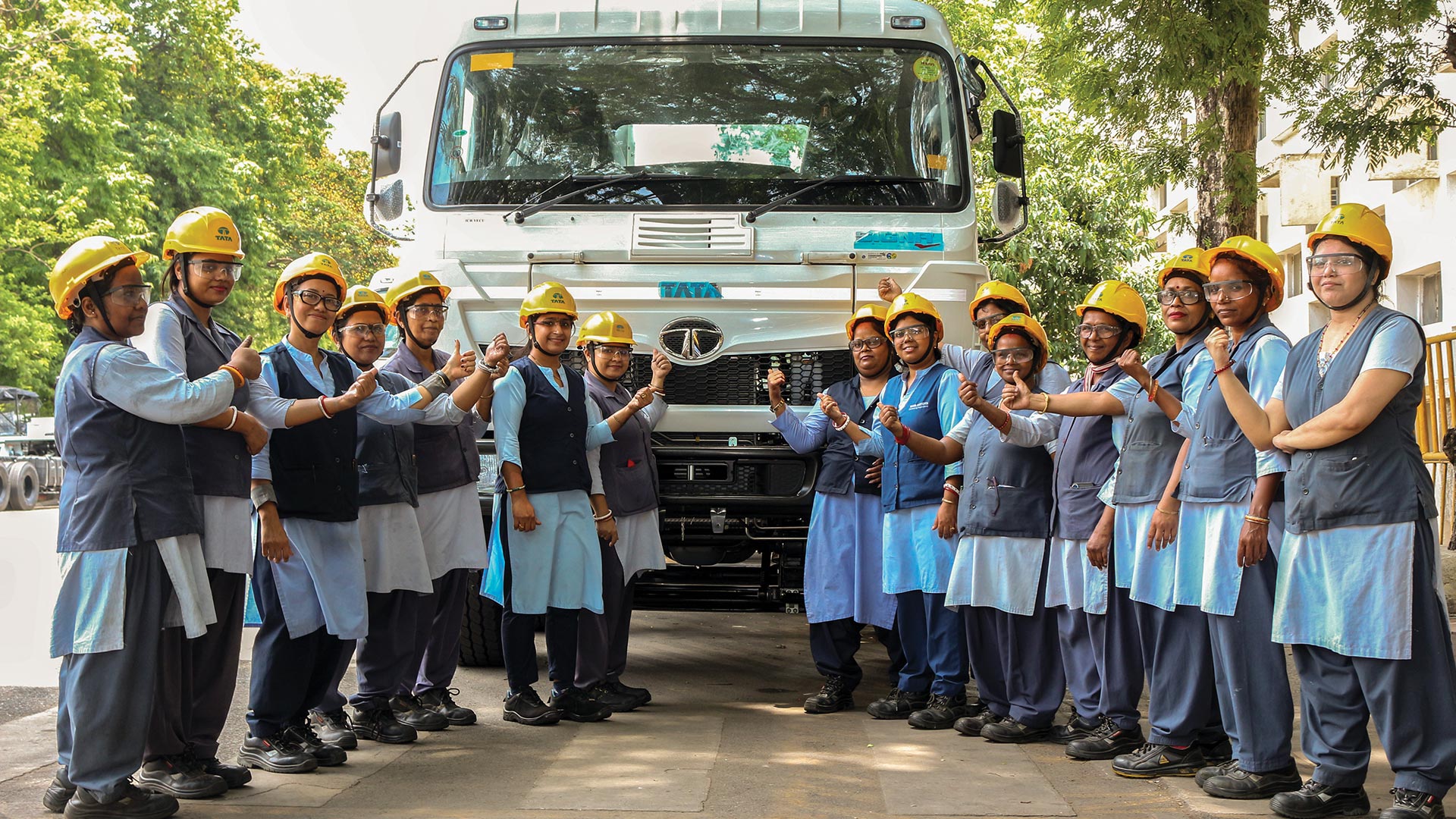November 2025 | 1370 words | 5-minute read
When Atashi Dutta joined Tata Motors’ Jamshedpur plant in 2017, the thought of operating complex machinery didn’t intimidate her nearly as much as the idea of working alongside men.
A homemaker until then, Ms Dutta stepped into the workforce after the sudden passing of her husband, a Tata Motors employee. Taking on his role and, with it, a new chapter would change the course of her life. “I went in with a single-minded focus on learning,” she says. “I had to leave all my reservations and inhibitions at the door because I had to support my teenage daughter, my parents, and my in-laws.”

Ms Dutta underwent extensive training sessions, including sessions on safety protocols and modules on Jishu Hozen (maintaining equipment performance), Total Quality Management, and the 5S principles for workplace organisation and standardisation: Seiri (sort), Seiton (set in order), Seiso (shine), Seiketsu (standardise), and Shitsuke (sustain). She also attended sessions on women’s health and hygiene, prevention of sexual harassment, self-defence, and the I Care programme, a Tata Motors community initiative.
Within two months, she moved to the shop floor. “I made sure I got my hands dirty tinkering with components,” says Ms Dutta. “It didn’t matter if it was part of my designated role or not.” Her growth mindset paved the way for her to become one of the first women eligible to join the Durga Line — the all-women Gearbox Assembly Line at Tata Motors’ commercial vehicle (CV) manufacturing facility in Jamshedpur, Jharkhand.

A self-sufficient unit
Launched in 2022, the Durga Line comprises 24 women working in a self-directed team (SDT) model — groups of employees manage their daily work, including planning, scheduling, and problem-solving, with minimal supervision. Today, the 47-year-old Ms Dutta is a mentor in one such SDT and works in the Transmission Shop on the Durga Line. As a team leader, she coordinates and plans daily operations. “We work with hydraulic and pneumatic machines, and tools such as gauges and carriers,” she explains.
The gear assembly process for heavy CVs is a complex, precision-driven task involving inspection, component preparation, gear assembly, and quality checks. The components assembled here are used in the Tata Prima line of heavy-duty trucks and the Tata Signa line — known for their robust engines and roomy cabins.
Diversity by design
The idea of the Durga Line took root in late 2020 when Tata Motors sought to improve gender diversity at its Jamshedpur facility. Amid the Covid-19 pandemic and a widespread manpower shortage, the company saw an opportunity. “That’s when we asked ourselves — why not identify women within the organisation and evaluate every role where they could be effectively deployed? It made strong business sense,” says Pranav Kumar, Head of Human Resources at the Jamshedpur plant.
Tata Motors was already a pioneer in this space. At its passenger vehicles (PV) plant in Pimpri-Chinchwad, Maharashtra, women build the Tata Harrier and Tata Safari SUVs from scratch — including lifting 15kg windshields. “From the outset, we were clear: this is not about charity; the technicians have to be productive,” says Mr Kumar, referring to the model in Jamshedpur. With strong support from the management and Sitaram Kandi, Chief Human Resources Officer, Tata Motors, the team began mobilising women already in the ecosystem — most of whom were in clerical or support roles — and started training them for roles on the manufacturing shop floor.

Laying the groundwork
Sujata Biswas, a Senior Manager at the plant, recalls when the Durga Line was set up. “We always had women in the plant, but it was fragmented. There was no dedicated line for them until we saw the potential of bringing them together,” says Ms Biswas, who joined Tata Motors in 2014 after completing her Bachelor of Technology in Mechanical Engineering.
To bring this vision to life, a cross-functional team, comprising experts from safety, medical, human resources, operations, and productivity, was formed to evaluate which roles on the shop floor would be a good fit for women. “We didn’t want to limit women to support roles,” says Mr Kumar. “We wanted them to assemble trucks, operate heavy machinery, and lead teams. In essence, to prove that they could do it all.” The way Sarbani Dasgupta did, for instance. A Tata Motors employee since 2006, Ms Dasgupta worked in finance and other departments until 2021. The following year, like
Ms Dutta, she transitioned to the manufacturing team and joined the Durga Line.
Ms Biswas notes that the Durga Line comprises women from diverse backgrounds — which explains why the transition isn’t always easy. Thirty-eight-year-old Reshmi Bagchi’s story illustrates this. When the Durga Line was launched, she was not only filled with self-doubt about her capabilities, she also faced resistance from her family. Born and raised in Jamshedpur, Ms Bagchi is married and has a son. “We kept wondering how an all-women team could run an entire assembly line, learn the operations, and still meet production targets,” she recalls. But she persevered and, today, Ms Bagchi serves as the Safety Point Leader in the Transmission Shop of the Durga Line. Along the way she has become adept at many skills, having worked in the Central Establishment, Plant 2 Cab Cowl Shop (Fitment and Fabrication Area), and the Central Receiving Station Gate.

"It is like an operation theatre"
The success of the Durga Line has inspired Tata Motors to replicate the model across its other manufacturing units in Jamshedpur. “Each factory produces different components for heavy commercial vehicles," says Mr Kumar. “And each will have a women-led line, different names, same model. For example, we plan to launch the Bhavani Line this year. These women tend to go the extra mile because they feel they need to prove themselves. If a man produces 50 units, they aim for 52," says Mr Kumar.
To support white-collar roles, Tata Motors has established a Skill Development Centre in Jamshedpur, for upskilling and training employees for the units they will eventually join. Another initiative, Learn, Earn and Progress (LEAP), Tata Motors’ flagship automotive skilling programme, involves a 12-month course that allocates 30 percent of the time to theoretical learning and 70% to on the job exposure at service centres. Run as a public-private partnership model, involving industrial training institutes and dealers, LEAP aims to provide sustainable livelihoods to unskilled youth, especially those from disadvantaged backgrounds.
“For shop floor roles, we offer both on the job and off the job training, says Mr Kumar. For example, if we are introducing battery assembly, we replicate the set-up in the training centre and train people for one to four weeks. For blue-collar roles, technicians are assessed based on their skill levels, beginner to advanced, and assigned either critical or support roles. “It is like an operation theatre; not everyone performs surgery. Some assist, some manage," he explains.
While training technicians, Ms Biswas realised that women often faced ergonomic challenges when operating the hydraulic press machine due to its height. “The idea of installing platforms came from the team during a brainstorming session, says Ms Biswas. “And the best part was that the management didn’t waste any time getting it done. Half our problem was solved with that one move," adds Ms Biswas.

The thrill is in the challenge
Ms Bagchi says the Durga Line is a high-performance unit. “Our goal is always ‘first shot okay’,” she says. “We train new technicians and check calibration to ensure every machine set-up is flawless.” The team has implemented the Japanese Poka-Yoke (mistake-proofing) technique, which involves creating proactive mechanisms to prevent, correct, or highlight errors in real time.
What makes the Durga Line stand out? According to Ms Biswas, it is the team’s ability to get the job done — and done well. She attributes this to the camaraderie they share. “There is tremendous cooperation among the women,” she says. “They don’t hesitate to step in when needed. It is not like we were always flawless; initially, there were mistakes. But we have learnt and grown, and there is a strong sense that we are in this together. When I first joined the Jamshedpur plant, I was one of the few women here. Over the past decade, that number has grown significantly — today, there are more than 1,300 women working at the plant. That is the kind of change we are talking about.”
- Anju Maskeri































